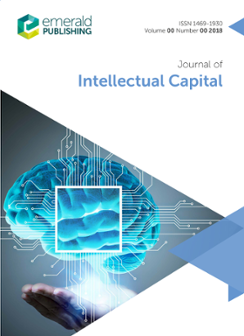Modeling intellectual capital-based intrapreneurial ability of working professionals through servant leadership and self-efficacy
IF 6.8
2区 管理学
Q1 BUSINESS
引用次数: 0
Abstract
PurposeIntrapreneurial ability (IA) of employees strengthens an organization's internal as well as external growth. Employees' IA makes innovation a continuous practice and augments organization's intellectual capital (IC). This intellectual capital-based intrapreneurial ability (ICIA) helps professionals to effectively handle changes in the business ecosystem by creating innovative solutions. The onus of assessing and inculcating ICIA is a joint responsibility of both academia and industry. In academia, teacher as a servant leader (TASL) contributes towards building ICIA of working professionals (WP) by enhancing their self-efficacy (SE). The paper aims to strengthen the industry–academia interface by analyzing the role of TASL and SE in influencing the ICIA of WP.Design/methodology/approachUsing a stratified sampling technique, data from 387 WP is analyzed on SmartPLS-4 to study the interrelationship between the stated constructs and the role of SE as a mediator between TASL and ICIA. PLSpredict is used to study the predictive relevance of the proposed model.FindingsHigh R2 = 0.654 shows that 65% of ICIA is determined by SE and TASL; reflecting model's robustness. SE partially mediates the relationship between TASL and ICIA. Results reported a higher ICIA of male WP than their female counterpart. The results indicate the low predictive accuracy of the model.Practical implicationsThe proposed model of industry–academia partnership allows assessment of ICIA for enhancing corporate value in the present gig economy. The study also highlights the relevance of ICIA, particularly, for developing economies. In knowledge-driven economy, exploring the new ICIA will help organizations to draft a more robust performance measurement system.Originality/valueThis unique industry–academia partnership studies the role of TASL towards enhancing SE and ICIA of WP. The novelty of ICIA would enrich and provide a new perspective in IA literature. Additionally, the study also examines the role of gender in the ICIA of WP.基于仆人式领导和自我效能感的在职专业人员基于智力资本的内部创业能力模型
目的:员工的内部创业能力(IA)增强了组织的内部和外部增长。员工的智力资本使创新成为一种持续的实践,增加了组织的智力资本。这种基于智力资本的内部创业能力(ICIA)通过创造创新的解决方案,帮助专业人士有效地应对商业生态系统中的变化。评估和灌输国际信息技术协会的责任是学术界和工业界的共同责任。在学术界,教师作为服务型领导者(TASL)通过提高工作专业人员的自我效能感(SE),有助于建立工作专业人员的自我效能感。本文旨在通过分析外语教学和英语教学对外语专业学习的影响,加强产学研之间的联系。设计/方法/方法采用分层抽样技术,在SmartPLS-4上分析了387份WP的数据,以研究所述结构与SE在TASL和ICIA之间的中介作用之间的相互关系。plpredict用于研究所提出模型的预测相关性。高R2 = 0.654表明65%的ICIA由SE和TASL决定;反映了模型的稳健性。SE部分中介了TASL和ICIA之间的关系。结果显示,男性WP的ICIA高于女性WP。结果表明,该模型的预测精度较低。实际意义提出的产学研伙伴关系模型允许对当前零工经济中提高企业价值的ICIA进行评估。该研究还强调了国际间信息系统的相关性,特别是对发展中经济体的相关性。在知识驱动型经济中,探索新的绩效评估体系将有助于组织制定更健全的绩效评估体系。原创性/价值这一独特的产学合作研究了TASL在提高工作能力的SE和ICIA方面的作用。信息学研究的新颖性将丰富信息学研究的内容,为信息学研究提供新的视角。此外,本研究还探讨了性别在WP的ICIA中的作用。
本文章由计算机程序翻译,如有差异,请以英文原文为准。
求助全文
约1分钟内获得全文
求助全文
来源期刊

Journal of Intellectual Capital
Multiple-
CiteScore
14.50
自引率
13.30%
发文量
27
期刊介绍:
The Journal of Intellectual Capital is a peer-reviewed international publication dedicated to the exchange of the latest research and best practice information on all aspects of creating, identifying, managing and measuring intellectual capital in organisations. The journal publishes original research and case studies by academic, business and public sector contributors on intellectual capital strategies, approaches, frameworks, tools, techniques and technologies in order to increase the understanding of intellectual capital within the context of the modern knowledge economy. The focus of this journal is on the identification of innovative intellectual capital strategies and the application of theoretical concepts to real-world situations.
 求助内容:
求助内容: 应助结果提醒方式:
应助结果提醒方式:


